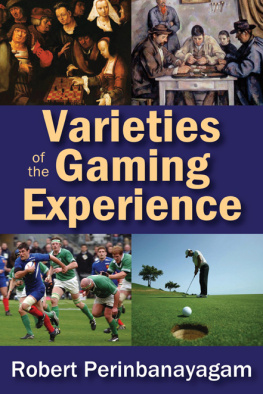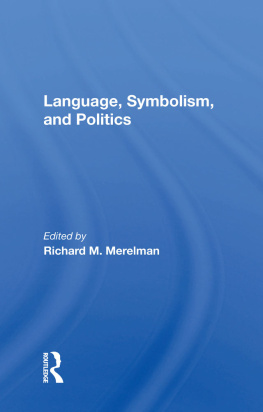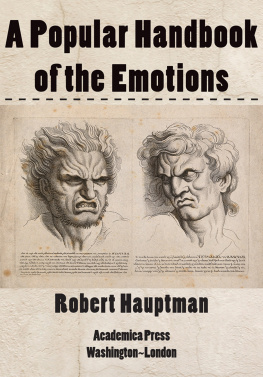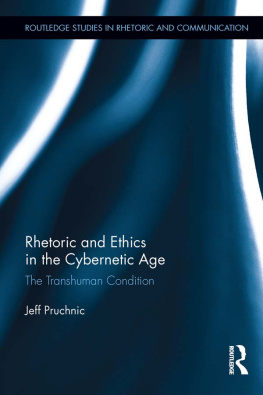First published 2016 by Transaction Publishers
Published 2017 by Routledge
2 Park Square, Milton Park, Abingdon, Oxon OX14 4RN
711 Third Avenue, New York, NY 10017
Routledge is an imprint of the Taylor and Francis Group, an informa business
Copyright 2016 by Taylor & Francis.
All rights reserved. No part of this book may be reprinted or reproduced or utilised in any form or by any electronic, mechanical, or other means, now known or hereafter invented, including photocopying and recording, or in any information storage or retrieval system, without permission in writing from the publishers.
Notice:
Product or corporate names may be trademarks or registered trademarks, and are used only for identification and explanation without intent to infringe.
Library of Congress Catalog Number: 2016026728
Library of Congress Cataloging-in-Publication Data
Names: Perinbanayagam, R. S., 1934- author.
Title: The rhetoric of emotions : a dramatistic exploration / Robert Perinbanayagam.
Description: New Brunswick, NJ : Transaction Publishers, 2016. | Includes bibliographical references and index.
Identifiers: LCCN 2016026728 | ISBN 9781412863964 (hardcover) Subjects: LCSH: Emotions (Philosophy) | Emotions in art. | Emotions in literature.
Classification: LCC B815 .P47 2016 | DDC 128/.37--dc23 LC record available at https://lccn.loc.gov/2016026728
ISBN 13: 978-1-4128-6396-4 (hbk)
Preface
In this work I propose an approach to the study of emotions that starts from the premise that human agents are primarily symbol-using and symbol-making creatures, as Kenneth Burke insisted, and anything plausible that can be said about such agents must begin with that premise. This is as true of the emotional features of their lives as of anything else. Emotions may have physiological substrates, and there may well be emotional brains and so on and so forth, but for all that, emotions are subject to linguistic labeling and classification. The making of fine distinctions and their experiencing by human agents is dependent on such symbolic/linguistic processing as agents interact with their own selves and with others. Insofar as emotions are experienced in situations and directed toward others, the propensity to make such distinctions by labeling and classifying these same others too are part of the emotive process.
After a general introduction to some central ideas from the work of Kenneth Burkes voluminous output, I examine in the pages that follow the ways human agents respond emotionally to various objects that are at their dialogic disposal. These include (besides other individuals and their conversations) music, novels, paintings, dances, and sculptures. Finally, I examine the complex emotional responses that attend the watching of plays and games as well as the reading of romances and climbing of mountains as adventures, in Georg Simmels sense of the term, as a dropping out of the continuity of life, of taking a road not yet taken.
I want to note that though I discuss famous novels and paintings in the course of my explication of the rhetoric of emotions, I do so neither as a literary critic nor as an art critic or a theologian but as a mere commentator on how readers, listeners, and watchers are likely to construct responses to the objects at their disposal. This work is about the vocabularies of motives with emotional valences that function as rhetorical strategies in the conduct of the relationships of everyday liferelationships with self and other and world.
In undertaking this task I will follow a very special methodological strategy. The social sciencesat least the most dominant branches depend on research-based statistics to make their points. By converting their major questions into forms that can be answered by counting occurrences of a phenomenon and then submitting their results to sophisticated mathematical procedures, social scientists are able to make conclusions that have a certain measurable probability of being true. One of the central principles in such research strategies is that the numbers on which the mathematical procedures are performed are taken as a representative samplethat it is probable that the smaller number of people to whom the questions of the research are submitted can be said to represent the total population, insofar as the sample members have been selected using various strict procedures. The researchers who undertake this kind of work, and their consumers, consider these procedures, and the strict mathematical exercises performed in them, to yield reliable and valid information, and assume that the researchers are, in fact, doing science.
Such sampling procedures exemplify the phenomenon of reduction, by which a large and unwieldy phenomenon is miniaturized, either to make it more manageable or to enable a very focused view of the phenomenon. Cooks, for example, boil down a soup to make it taste stronger; writers express complex and recalcitrant ideas in poems, even in simple quatrains; and Persian and Indian miniature painters distilled rich, universal themes to fit inside tiny frames. Such reductions undoubtedly make the social sciences more efficient in reaching their targeted audience as well as more effective, insofar as the audience can pay more focused attention to the objects in question. It is possible, if one has the necessary tools and imagination, [t]o see a World in a Grain of Sand, and a Heaven in a Wild Flower, Hold Infinity in the palm of your hand, as the poet William Blake observed in his own miniaturized way. This method of doing sociology can in fact be called the Durkheimian strategy: study the relatively simple religious practices to make sociological claims about religion in general.
Nevertheless, the data that have been collected by employing these methods of sampling, and the mathematical procedures performed on them, are inescapably rhetorical exercises that are used to persuade the scientists and their consumers that the findings from these research programs can be taken as the real state of affairs. Most of the consumers would not be able to do such inquiries on their own and will be persuaded by the rhetoric of the methods employed to accept the conclusions as valid and reliable. It is important to note that saying these are rhetorical moves does not necessarily undermine the validity of these methods or their findings. This claim is also not being made to in any way denigrate or downplay the importance of the work the social sciences do.
Yet the idea that a small number of cases can represent the whole raises further questions: How large should the sample be, on the one hand, to be a representative of the whole? And, on the other hand, can a very small number of cases, like ten or twelve, or even one or two, be used to make a point, claim a finding, and establish its validity as a contribution to the understanding of human relationships and the societies in which these relationships are conducted?









